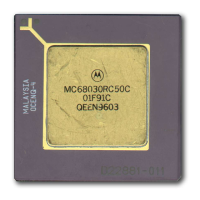Instruction Set Summary
MOTOROLA
MC68030 USER’S MANUAL
3-3
The following notations are used in this section. In the operand syntax statements of the
instruction definitions, the operand on the right is the destination operand.
An = any address register, A7–A0
Dn = any data register, D7–D0
Rn = any address or data register
CCR = condition code register (lower byte of status register)
cc = condition codes from CCR
SR = status register
SP = active stack pointer
USP = user stack pointer
ISP = supervisor/interrupt stack pointer
MSP = supervisor/master stack pointer
SSP = supervisor (master or interrupt) stack pointer
DFC = destination function code register
SFC = source function code register
Rc = control register (VBR, SFC, DFC, CACR)
MRc
= MMU control register (SRP, URP, TC, DTT0, DTT1, ITT0,
ITT1, MMUSR)
MMUSR = MMU status register
B, W, L = specifies a signed integer data type (twos complement) of
byte, word, or long word
S = single-precision real data format (32 bits)
D = double-precision real data format (64 bits)
X = extended-precision real data format (96 bits, 16 bits unused)
P = packed BCD real data format (96 bits, 12 bytes)
FPm, FPn = any floating-point data register, FP7-FP0
PFcr
= floating-point system control register (FPCR, FPSR, or
FPIAR)
k = a twos-complement signed integer (–64 to +17) that specifies
the format of a number to be stored in the packed BCD format
d
= displacement; d
16
is a 16-bit displacement
〈
ea
〉
= effective address
list = list of registers, for example D3 — D0
#
〈
data
〉
= immediate data; a literal integer
{offset:width} = bit field selection
label = assemble program label
[m] = bit m of an operand
[m:n] = bits m through n of operand

